|
| |
Styles in Ribbon Versions of Microsoft Word (2007-2019)
Draft - not done
For Word 97-2004 see Understanding Styles in
Microsoft Word.
Last edited by Charles Kenyon on
Tuesday 03 January 2023
What You Will Learn
After completing this lesson, you will be able to:
Additional Written (and Web) Resources
 | Word for Law Firms by
Payne
Consulting Group:
 |
Tips for Understanding
Styles in Word by Shauna Kelly, MVP |
 |
How
Styles in Microsoft Word Cascade by Shauna Kelly, MVP |
 |
Where are all the Style Controls - Office Watch |
 |
Style Basics in Word 2007 (& 2010) - Microsoft |
 |
Seven Laws of Styles (Word of Law) by Bob Blacksberg |
 |
Styles
in a Networked Environment - newsgroup discussion |
 |
Create
a Template Part 2, John McGhie, MVP. |
 |
Template Basics in Microsoft Word
by Charles Kenyon |
 |
What is the difference between the normal
Style and the Body Text Style?,
Suzanne Barnhill, MVP |
 |
Yet Another "Use Styles" Verbal Beating! by Dian Chapman, MVP |
 | Letterhead
System - Styles used to format letters and letterhead |
 | Letterhead
Textboxes and Styles Tutorial - two-page template download that
demonstrates use of
 | Styles that are based on each other and use the Style for
following paragraph feature |
 | Use of the StyleRef field to insert information from the body of
a letter into the continuation page headers automatically |
 | The AutoText list restricted by Styles for the salutation and
closing. |
 | Textboxes in headers and footers to reserve space for preprinted
letterhead |
 | Insertion of a date
automatically that will not change when you open the document at a
later date |
 | Insertion of the typist's name as signer automatically by
accessing the Author document property. |
|
 |
StyleRef Field
Tutorial by Charles Kenyon |
 | IncludeText
Field Tutorial - 2 documents with IncludeText links demonstrating
switches, interaction of Styles, and use of hidden Page field for continuous
page numbering of separate documents. |
 |
Headers?
Headings? What is the difference? |
  | AutoText
Sampler - Styles used to organize AutoText - see also... |
 |
Why does text change format when I copy it into another document?
by Shauna Kelly, MVP |
 |
What happens when I send my document to someone else, will the
formatting change? by Shauna Kelly, MVP |
 |
Tying numbering to Styles - How to create numbered headings or
outline numbering in Word 2007 and Word 2010 by Shauna Kelly,
MVP |
 |
How
to add pop-up lists to any Word document by Bill Coan, MVP.
|
 | A Global
StyleSheet in Microsoft Word?
by Charles Kyle Kenyon |
 | Word
is always making changes I don't expect. How can I get more control
over my formatting? by Suzanne S. Barnhill, MVP, and Dave Rado,
MVP. |
 |
So You
Want to Write a Book Using Microsoft Word - extensive tutorial
by MVP Daiya Mitchell with overview of Styles,
Templates and
Sections and the interactions among these tool/features.
Excellent! Not just for those who want to write books! |
 |
Word Tips about Styles from Allen Wyatt - Note, most tips have
versions for Ribbon versions of Word (2007+) and pre-ribbon
versions. A few of the tips are listed below.
|
 | (Advanced) How
to safely update a document's Styles from its template without using
the Organizer (and how to make the Tools + Templates and Add-ins
dialog safe) by Dave Rado, Margaret Aldis, Ian Sharpe and Beth
Melton. |
 | How
to Apply a Style in Microsoft Word by Shauna Kelly |
 |
How
to Modify a Style in Microsoft Word by Shauna Kelly |
 |
How to Control the Quick
Styles Gallery on the Home Tab by
Shauna Kelly (Word 2007-2013) |
 |
Creating and Sharing Custom Microsoft Word Styles by Deborah
Savadrah - especially good on creating new Style Sets and sharing
them in ribbon versions of Word |
 |
Why
Does Text Change Format When I Copy It Into a Different Document?
by Shauna Kelly |
 |
How
Styles in Word Cascade by Shauna Kelly |
 |
Table
Styles Not Useful by Shauna Kelly |
 |
Formatting applied to one paragraph affects entire document by
Suzanne S. Barnhill, MVP |
 |
Useful StyleRef Field Tricks by Suzanne S. Barnhill, MVP |
 |
Styles DropDown Keyboard
Access Add-In - (For Word 2002+) Simple Add-In to give keyboard
(Ctrl+Shift+S) access to the Styles DropDown in the Formatting
Toolbar |
 |
Char and Char Char Char Styles - a Bug and fixes |
 |
Styles Dialog Box Add-In
- (For Word 2003+) Simple Add-In to give menu access to the Styles
Dialog Box |
 |
How to put Word 2002 (and 2003) back the way they were in Word
97-2000 by Suzanne S. Barnhill, MVP (getting access to the
Styles dialog box instead of the Task Pane) |
 |
How to Control Bullets in Microsoft Word by Shauna Kelly, MVP.
Bullets and outline numbering are very much related in Word. You use
Styles to implement either in a reliable way. |
 |
How to reinstate the Styles combo box in Microsoft Word 2007 - Word
2013 by Shauna Kelly, MVP. (Add the Styles combo box from Word
2003 to the QAT in ribbon versions.) |
 |
Word 2007/2010: Behind the Curtain - Styles, Doc Defaults, Style
Sets and Themes - by Microsoft Word Team |
 |
Word 2007/2010: Behind the Curtain - Styles Order of Operations - by Microsoft Word Team |
 |
OutlineNumbering
by Shauna Kelly, MVP (see note above) |
 |
Changing the formatting rules with compatibility options - these
can change how Word treats formatting in Styles. |
 |
Styles Order of Operations Microsoft Blog |
 |
Microsoft Word 2010 Bible by Herb Tyson,
MVP |
 |
Why Use Styles - part of Lynda.com Video tutorials on Word |
 |
Using the Navigation Pane in Word 2010 |
 |
Word 2007 and later - Behind the Curtain - Styles, Style Sets,
Document Defaults and Themes |
|
 
(this guide table of contents) ------- (MS
Word New Users FAQ)
Introduction
This page is a companion to Understanding Styles in
Microsoft Word. It is to examine the handling of Styles in the Ribbon
versions of Word. All of the concepts are the same but the Ribbon versions
give more controls and ways to access Styles.
Styles are arguably the most important feature in Microsoft Word. Why?
Because everything that you do in Word has a Style attached. The
definition of a Style is two-fold. First, you can think of a Style as a
set of pre-defined formatting instructions that you can use repeatedly
throughout the document. Let's say each heading in a document must be
centered, uppercase, bold, and a slightly larger font size. Each time you
need to apply formatting to the heading, you have to go through the entire
process to get the text the way you want it. If you store the formatting
commands in a Style, you can apply that Style any time you need it without
having to do all of the reformatting.
Possibly more important however is that Styles are used to "tag" or
identify parts of a document. An example of this is whether text is part
of a heading, a footnote, a hyperlink, or body text. These are all
examples of Styles in Word.
If you're concerned about whether or not you need to learn Styles, we
can put it rather simply: you do. Styles are the architecture upon which
Word is based. Just about everything in Word is Style-driven. In fact,
many people in the industry refer to Word as a "Style-driven" program.
Allen Wyatt uses an elegant metaphor to explain Styles:
"Styles are nothing more than a named definition of how text
should appear. You can best understand this by comparing your text to
water (this is your content). The appearance of the water depends on the
attributes of the container in which it is placed. If you place it in a
glass it will look one way; if you place it in a pitcher, it looks a
different way. The relationship between text and Styles is no different;
if you change the Style that has been applied to text, then the
appearance of the text automatically changes."
Understanding Styles
Styles allow for quick formatting modifications throughout the document
and can be tied into numbering to make working with outline numbered lists
easier.
"While the Styles gallery has been available on the Word home tab
since Word 2007, some people just assume Styles are meant for people who
want big blue text.

"As it turns out, that’s not true. I’m here to tell you that
Styles are handy, and if you use them to format your text as you write
your document, you’ll be able to take full advantage of the improvements
in Word 2013 that we’ve outlined below."
-- Caitlin Ashley-Rollman, Microsoft
Program Manager for Word 2013 in
blog on using Styles
|

|
CK
Note: For long documents,
documents that are likely to be heavily edited, and documents that may
form the basis for other documents, follow the basic rule that to change
formatting use Format => Styles... Do not apply direct formatting.
In Ribbon versions of Word (2007+) this is even easier, click on
your Style from the Quick Styles gallery!
You
will save yourself, and others, untold hours of hair-tearing. For shorter
one-use documents, direct formatting is OK; you'll only regret not using
Styles about one time in six, on the other five out of the six, you'll
save a bit of time. If you create document templates
with direct formatting, you deserve what will happen to you when someone
finds out (and it won't be nice). In my opinion, using direct formatting
in document templates intended for use by others rates the words malicious
and/or incompetent. If the templates are for your own use,
you deserve the loss of days, months, even years from your life that
you'll spend fighting with Word and trying to figure out why your
documents look so bad.
Trying to use Word without understanding and using Styles is like
pushing on a string. I resisted learning and using Styles for years
and now regret every day of those years because although that string
was still very hard to push, it kept getting longer and longer, and
had some very important projects tied to it! Once you understand
Styles and the Word concept of organizing things into Chinese boxes
everything falls into place and instead of pushing a string, you can
push a button that turns on the very powerful text processing
machine known as Microsoft Word and it will start doing your work
for you instead of running around behind you trying to undo what you
thought you just did. These statements should be even stronger for
those using Word 2007-13. These versions let you use and change
Styles even more
easily. |
I just had occasion to edit a 100-page document that
was created without using Styles. It was formatted completely with
direct formatting. Each page ended with a page break.
Each time it had to be saved, the save took more than 60
seconds, during which time Word was frozen.
A similar-sized document
formatted using Styles takes less than 3 seconds for me to save.
When a page break must be forced, instead of using a manual page
break, the paragraph to begin the new page is formatted using a
Style that has "page break before" paragraph formatting.
This difference was due entirely to the document being directly
formatted - a much higher level of complexity. Each paragraph mark
in a directly-formatted paragraph carries with it up to fifty
different formatting commands. When formatted using a Style, that
paragraph mark will carry with it one command - use this Style!
--CKK 1 Feb 2012 |
There are several reasons for using Styles in a document:
 | Consistency — When you use Styles to format your
document, each section is formatted the same and therefore, provides a
professional, clean-looking document. |
 | Easier to Modify — If you use Styles in your document
consistently, you only need to update a given Style once if you want to
change the characteristics of all text formatted in that Style. |
 | Efficiency — You can create a Style once, and then apply
it to any section in the document without having to format each section
individually. |
 | Table of Contents — Styles can be used to generate a
table of contents quickly. |
 | Faster Navigation — Using Styles lets you quickly move
to different sections in a document using the Document Map feature. |
 | Working in Outline View — Styles allow you to outline
and organize your document's main topics with ease. |
 | Legal Outline Numbering – Numbering, when linked to
Styles,
allows you to generate and update consistent outline numbering in legal
documents, even ones with complicated numbering schemes like municipal
law, tax law, and mergers and acquisitions documents. |
 | Efficiency of Word — Files which are predominantly
manually formatted are less efficient than those which have formatting
that has been imposed by Styles: manually formatted files, such a
converted documents which have been File, Opened, are bloated in file
size (bytes) and do not render to the screen efficiently when you scroll
through them. This is because Word is a Styles-based application: it
first reads the attributes of the underlying Style, then has to
broadcast anything contrary (e.g. manually formatted on top of that). As
such, a lengthy document that has been predominantly manually formatted,
will behave sluggishly because Word has to work harder at managing it.
Additionally, the print formatting processes are equally labored as
opposed to using Styles. |
 | HTML AND XML — What lies ahead? A fully structured,
Styled document will move into HTML and XML incredibly well. |
Styles are an essential part of Microsoft Word. In fact, everything you
type into a document has a Style attached to it, whether you design the
Style or not.
When you start Microsoft Word, the new blank document is based on the
Normal template, and text that you type uses the Normal Style. This means
that when you start typing, Word uses the font name, font size, line
spacing, indentation, text alignment, and other formats currently defined
for the Normal Style. The Normal Style is the base Style for the Normal
template, meaning that it's a building block for other Styles in the
template. Whenever you start typing in a new document, unless you specify
otherwise, you are typing in the Normal Style.
| "Avoiding Styles is a hobby for some Word users. They go through 35
mouse clicks in 12 formatting dialog boxes, just to avoid using a
Style."
Getting Started with Styles by
Dian Chapman |
Paragraph vs. Character Styles vs. Linked
Styles
There are two types of Styles in Microsoft Word;
character and paragraph. Paragraph Styles are
used more frequently than character Styles, and they are easier to create.
It's important to understand both, however, since understanding Styles is
so important.
Character Styles can be applied to individual words — even (you
guessed it) single characters. Character formatting is built from the
formatting options available from the Format menu, by selecting Font;
settings from the Tools menu, by selecting Language, and then selecting
Set Language; and in certain cases from the Format menu by selecting
Borders and Shading, and looking on the Borders and Shading tabs of the
Borders and Shading dialog box. The following table shows the formatting
that can be in a Style.
A paragraph Style contains both font and paragraph formatting which
makes it more flexible than a character Style. When you apply a paragraph
Style the formatting affects the entire paragraph. For example, when you
center text, you cannot center a single word. Instead, the entire
paragraph is centered. Other types of paragraph-level formats that Styles
control are line spacing (single-space, double-space, etc.), text
alignment, bullets, numbers, indents, tabs and borders.
| Formatting |
Character Style |
Paragraph Style |
| Font |
Yes |
Yes |
| Tabs |
No |
Yes |
| Border |
Yes |
Yes |
| Spacing |
No |
Yes |
| Alignment |
No |
Yes |
| Indents |
No |
Yes |
| Shading |
Yes |
Yes |
| Language |
Yes |
Yes |
| Numbering |
No |
Yes |
I have three character Styles in most of my pleading documents. Two
replace Bold and Italic formatting. The third is for citations. The first
two are built-in character Styles of "Strong" and "Emphasis." I started
using these before Word had a replace formatting feature. I'm not sure they
are needed. They provide a simple way of changing how I emphasize something
throughout a document by simply changing the Style. It starts out that
"Strong" is bold and "Emphasis" is Italicized.
The third, though, has proved its worth through time. It is the Citation
character Style. I set it to Italic and set the language formatting to "no
proofing." This means that case citations with it will not alert the spell
checker. (Of course, this also means you better have the correct spelling.)
It also disables automatic hyphenation. To set this up, you would create a new character
Style and use the
formatting drop-down to add the Italic and "no-proofing" formatting. The
Italic formatting comes through the font formatting dialog, and the
"no-proofing" comes through the language dialog. In later versions
of Word "no-proofing" is known as "Do not check spelling or grammar."
Character Styles can also be used as targets for the
StyleRef field. This field gives very quick automatic updating. A
character Style is much less fragile than is a bookmark when used to
mark text that may be edited. I will often use character Styles that
apply to only one word or phrase in a document that I want to repeat
elsewhere, instead of a bookmark. Then a
StyleRef Field is used instead of a Ref field to repeat it
elsewhere.
The Heading Styles -
Special or Magic Styles
The built in heading Styles in Word have special
properties that make them almost magical. There are keyboard shortcuts
for the top three. They can appear without any customization in a Table
of Contents generated by Word, you can link and navigate to them with
cross-referencing features, and more. See
Why use Microsoft Word’s built-in heading
Styles? by Shauna Kelly,
MVP, for sixteen reasons to use these Styles.
Use a Style Separator to
Put Different Paragraph Styles in the Same Printed Paragraph
The primary reason to do this is when you want a
snippet from the beginning of a particular heading to appear in a
Table of Contents but don't want the entire heading in the Table
of Contents.
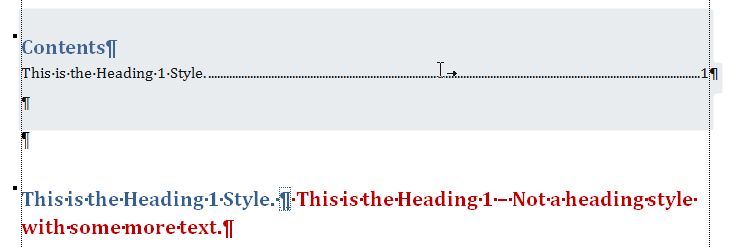
The screenshot above, with non-printing formatting
marks displayed, shows two different paragraph Styles used in one
logical printed
paragraph. Note the pillcrow (paragraph mark) with the dots around it separating the
two. The colors of the Styles here are different. The usual use of
this, though, would be for the Styles to look the same. This was
used in automatically generating the Table of Contents. The second
part of the paragraph, in the non-heading Style did not get picked
up in the Table of Contents.
You would not want to base the second Style
on the heading Style though, because then it would also be a heading
Style. This is, instead, based on the Body Text Style and formatted
using the same font and size as the Heading 1 Style.
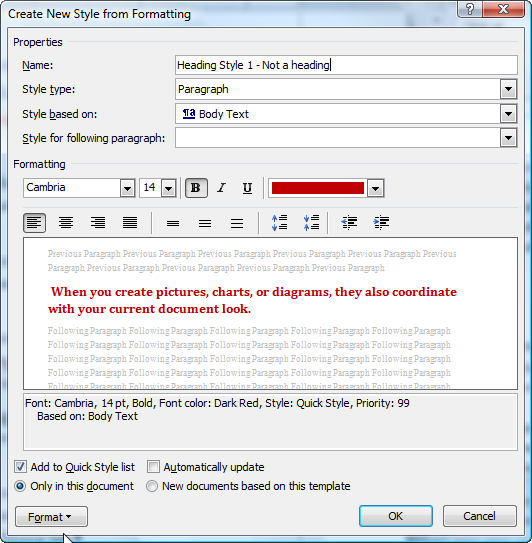
You can add a Style Separator to the end of a
paragraph using the Ctrl+Alt+Enter Keyboard Shortcut. Then you add
your text for the separate Style.
See
this thread on the Microsoft Answers forum for more.
Styles are listed in at least two places. The one most users are
familiar with is the Quick Styles Gallery on the Home Ribbon.

If you click on the dialog launcher in the bottom right of this group
you get a Styles Pane that gives more controls, more Styles and more
choices:

The resulting dialog is similar to the Styles Pane and provides more information about the
Style when you
hover.
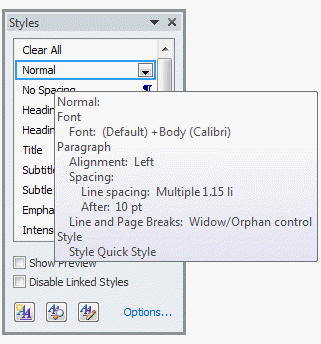
As in earlier Word versions, hovering over the Style name gives a
pop-up with information about the Style, and right-clicking on the
Style name give options to
modify or delete the Style.
Another way to launch the Styles Pane is the keyboard shortcut
Ctrl+Alt+Shift+S. (On my computer HP has grabbed this shortcut
for its System Info utility and it does not work in Word.)
By default this appears as a floating dialog. This dialog can be
anchored to the right side of the page making it appear much like
the Styles and Formatting Pane. Double-click on the title area
(Styles) to anchor it. Drag that title bar into the page to float it
again.
| |
 In Word 2007 and later
at the bottom of this Style pane there are two checkboxes, three buttons,
and the Options... choice. In Word 2007 and later
at the bottom of this Style pane there are two checkboxes, three buttons,
and the Options... choice.
The Show Preview checkbox shows the Styles in the list as
previews of the Style. The Disable Linked Styles checkbox
changes how applying a linked Style in a document behaves. If
"Disable" is checked, the linked Style behaves as a paragraph
Style
only when applied to a part of a paragraph. That is, the Style is
applied to the entire paragraph, not just the selected portion.
The left-most button lets you define
a new Style. The second gives you the Style Inspector.
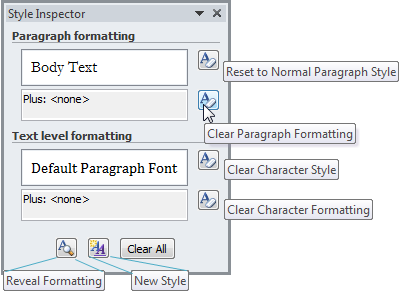
The Style Inspector is a floating dialog that lets you type in
your document and click to a different spot in the document to see
what is going on with formatting there.
If the
advanced editing option to "Keep Track of Formatting" is checked
it will also show direct formatting.
The purposes of the buttons is shown in the tooltips in the
screen shot.
The Reveal Formatting button gives the user the same pane as the
Keyboard Shortcut Shift+F1.
|
| |
The third button gives you the tabbed dialog to "Manage
Styles." The Manage Styles dialog has four tabs at the top giving
access to four different sets of controls to manage Styles.

At the bottom of each tab of this dialog are choices for "Only in this
document" or "New documents based on this template" as well as the
buttons for Import/Export, OK and Cancel. The choices for the
"scope" of the change (this document/template) are applied when the
OK button is pressed under any of the tabs. You can set options
under each tab before pressing OK. If you change your mind before
pressing OK and cancel, none of the changes under any of the tabs
are applied.

At the top of each tab is a
Sort order drop down. The choices are:
- Alphabetical - used by many experienced Word users who know
the names of the Styles including their custom Styles

- As Recommended - the default - uses choices set under
the Recommend tab
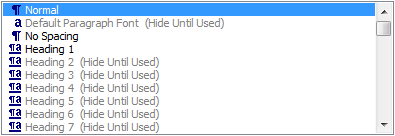
- Font - sort first by font being used - then alphabetically -
Many Styles, by default, are based on the Theme fonts +Headings
and +Body. If you are using Themes, you want to keep them this
way.
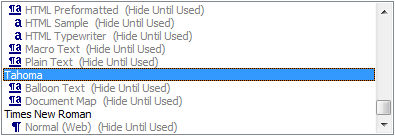
- Based on - sort by base Styles - see
How Styles in Microsoft Word cascade . Note the Heading
Styles shown below are set up as recommended in the article, not
the way they come by default.
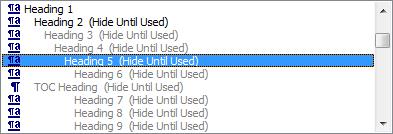
- By type - character, linked, paragraph... and then in
alphabetical order
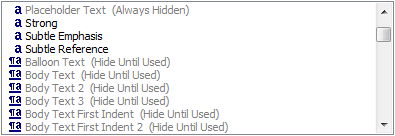
Next to the Sort order choice is a checkbox to "show recommended
styles only." If this is checked you will only see styles that are
not hidden. (See Recommend tab) These choices set at the top of any
tab of the Manage Styles dialog carry over to the other tabs in the
Manage Styles dialog. Unlike choices made on the Styles Pane Options
dialog, they do not change display of Styles in other Word dialogs.
Manage Styles Dialog
The first tab is Edit.
Edit Tab in
the Manage Styles Dialog
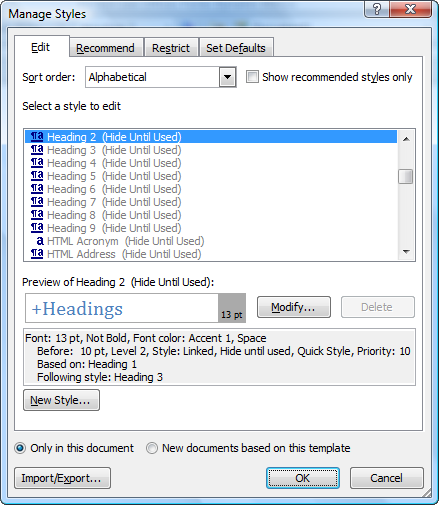
The controls under the Edit Tab are basically the same controls you
have when you right-click on a Style name in the Styles pane.
You can modify a Style or create a new Style using the buttons on
the Edit tab dialog.
You can see a summary of the Style's definition just as you do
when you hover over the Style name in the Styles pane.
|
| |
Recommend Tab
in the Manage Styles Dialog

Shown to the left is the Recommend tab which lets
you assign recommendation values and mark styles to be hidden or
displayed in lists. Those values determine where Styles show up in the Quick
Styles gallery and the order if you
display Styles "as recommended." Styles can have the same
values, in which case they will be sorted alphabetically.
It also lets you hide Styles from various views either until used
or always.
(When a style has ever been used in a document, it will show up
in the list of Styles in Use even if it is not actually in use.)
|
| |
Restrict Tab
in the Manage Styles Dialog

The Restrict page lets you make certain styles unavailable to the
user of your document/template. |
| |
Set Defaults
Tab in the Manage Styles Dialog

The Set Defaults page lets you change the default settings more
globally. Note, changing from +Body or +Headings may divorce you
from Style Sets settings and/or Themes. |
| |
Finally, you can also change your Style pane's display options.
The options for which Styles to show and their order operate in the
same way as the choices in the Manage Styles dialogs except they
have a more global effect in Word. If you click on
Options... in the Styles Pane you will
get...

When the OK button in the Styles Pane Options dialog is clicked,
it changes not only the Styles Pane display but also how Styles
lists in other Word functions are displayed. The Styles display in
the Find/Replace Styles formatting lists is changed by the sort
order picked in the Style Pane Options dialog! If you've added the
Styles Box to your QAT, that display is also changed by this dialog.
If you choose to show Styles "in Use" you will see all Styles
currently (or previously) used in the document. If you choose to
show Styles "in current document," you will see Styles currently (or
previously) used in the document plus at least the Heading 1 style.
If you choose "Recommended" the list will follow the settings in the
Manage Styles - Recommend dialog. |
Modify the Quick Access Toolbar (QAT) to give
more access to Styles

The screen shot above shows two tools for using Styles on the QAT.
The first is the Style Box drop-down (extended here) from earlier
versions of Word. The second launches the Styles Pane.
The Style Box will always display the Style in use where you
are typing. You can type a Style name into the box to change to that
Style. You can also drop it down to pick a Style.
See Modify
the QAT for more on modifying the Quick Action Toolbar. The
commands you need are both found under "Popular Commands." They are Syle
and Styles...
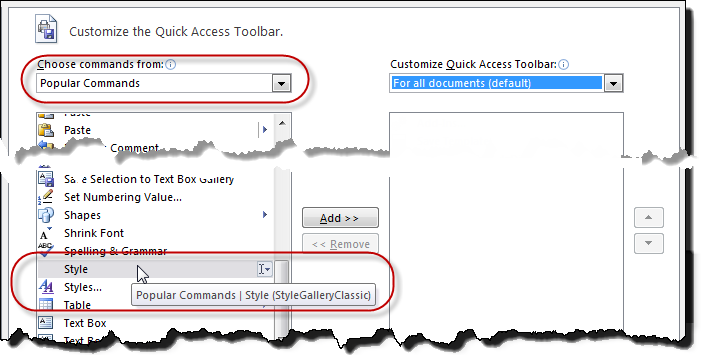
Practice: View a List of Styles
- Create a new blank document.
- Locate the Style box on the Formatting toolbar. If the toolbar is
not visible, alternate-click any toolbar and choose Formatting.
 |
Note In Word 2000, Styles are listed in
alphabetical order. In Word 97 Styles listed in the drop-down list
are not displayed in alphabetical order. Word 97 lists Styles in the
following order in the Style Box list:
 | Heading Styles |
 | Normal Style |
 | User-defined Styles in alphabetical order |
 | Body Text Styles |
 | List Styles |
 | All other Styles listed alphabetically. |
|
- Click the Style box drop-down arrow to the right of the button. A
list of Styles available in the active document displays.
While only a few Styles show in this list by default, later you'll
learn how to access all available Styles.
The list and quantity of Styles that displays in the Style list depends
on which template you used to create the active document. If you click the
New button on the Standard toolbar, you get a blank document based on
Word's default template, Normal.dot. Different types of documents need
different Styles. What works in a pleading may not be useful in a letter,
fax or memo.
Styles can also share the same name in various templates but have
different attributes. For example, in a pleading the Body Text Style may
be double-spaced, where in a letter, Body Text may be single-spaced.
Another way to see the Styles available in the current template is by
selecting the Format menu, and then choosing Style. The Style dialog box
is shown in the following figure.
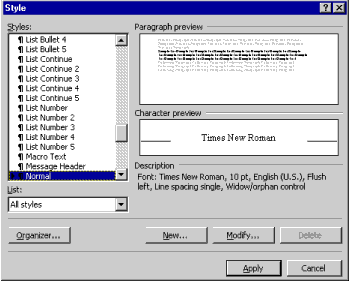
Styles list in Word 97-2000. When you select a Style from the list on the left side of the
Style
box, you see a preview and description of the Style formatting on the
right.
Practice: Access the Style Dialog Box
- From the Format menu, choose Style.
- Change the List to display All Styles if necessary.
- Select a Style from the list and view the Character preview,
Paragraph preview, and Description.
- Click Cancel or press ESC to close the Style dialog box.
Lists of Styles available in this template or all open templates are
shown in the Style dialog box.
Listing All of the Styles
When you click the Style button's drop-down arrow, only the Styles in
use in the current template displays in the list of Styles. If you wish to
see a list of all of the Styles that are available to you in Word, you can
do so in one of two different ways. Hold SHIFT and click the Style
drop-down arrow. This displays all Styles available. There are
approximately 125 Styles to choose from, excluding any user-defined
Styles. It's also possible to list all Styles by selecting All Styles from
the Style dialog box's List control in the bottom left corner.
Practice: View All Styles
- Create a new blank document.
- Click the Style drop-down arrow. Notice how many Styles are
available.
- Click with the mouse in the document to deselect the Style drop-down
list.
- Hold SHIFT and click the Style drop-down arrow again.
- More Styles are available when you hold down the SHIFT key.
The same rules that apply to direct formatting of text apply to Style
formatting of text. If you want to apply a text attribute to a single
word, you can click anywhere in the word and select a formatting option
such as bold, italics or underline — Word applies the selected format
to the entire word. Similarly, if you want to format multiple words you
must first select the multiple words. The same is true for applying
character Styles. To apply a character Style, you can click in the middle
of any word and select the character Style to format the entire word. If
you want to change a group of words you must first select the text before
applying the character Style.
Applying formatting to paragraphs is a little different. Just click
anywhere in a paragraph and apply direct formats such as dragging the
ruler to change indentation — since paragraph formats affect an
entire paragraph, you don't have to select the paragraph. If you want to
affect multiple paragraphs, you must first select the multiple paragraphs.
And, similar to applying text formatting and character Styles, to apply a
paragraph Style, click within the paragraph and apply the paragraph Style.
Or, select multiple paragraphs to apply the same Style to each of the
selected paragraphs.
|
 |
CK
Note: As of Word 2002
(and later) if you attempt to apply a paragraph Style to selected
text within a paragraph, you get a new character Style with the same
name. The character formatting from the paragraph Style is applied,
but not the paragraph formatting. A new hybrid character Style
with the same name but with "char" appended is created. To
apply a paragraph Style to a single paragraph, click within the
paragraph without selecting text. |
Practice: Apply Styles
- Type the following text into a new document.
Profitability
Report
Entire Firm
Individual Departments
Bankruptcy
Corporate
Health Care
Immigration
Trust and Estate
- Click anywhere within the first line, Profitability Report.
- Click the Style drop-down arrow and select Heading 1.
- Select the two paragraphs: Entire Firm and Individual Departments.
- Apply Heading 2 Style to the selected text.
- Apply Heading 3 Style to the department names.
There are several keyboard shortcuts that are useful in applying
Styles:
| Keyboard Shortcut |
Style Name |
| CTRL+ALT+1 |
Heading 1 |
| CTRL+ALT+2 |
Heading 2 |
| CTRL+ALT+3 |
Heading 3 |
| CTRL+SHIFT+L |
List Bullet |
| CTRL+SHIFT+N |
Normal |
| CTRL+SHIFT+S |
Activates the Style Drop-Down List |
 |
Tip The above shortcut keys are standard in
Word documents. You can also assign a shortcut key combination to
any other Styles that you use regularly. This topic is covered in
the section
Assign a Keyboard Shortcut To a Style. |
Display Paragraph Style Names in Normal View
Sometimes it's useful to see what Style has been applied to text within
a document. You can turn on Word's Style Area feature to see what
paragraph Styles have been applied throughout the document. The Style Area
is a re-sizeable pane on the left side of the window that lists the
paragraph Style applied to each paragraph. It is only available in Normal
View.
Practice: Display Applied Paragraph Style Names
- From the View menu, choose Normal (Word 97-2003).
- From the Tools menu, choose Options and select the View tab.
- Locate the Style area width box.
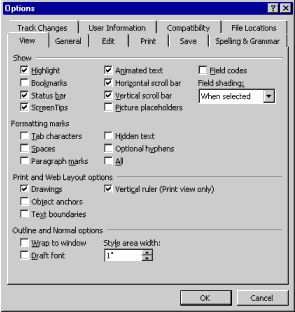
- Click the up spin box arrow until it's set to 1.0, or type 1.0 in
the box.
- Click OK to close the Options dialog box.
In Word 2007-2013 this is done under the Word Options > Advanced >
Display

 |
Tip To make the Style area width larger or
smaller without redisplaying the Options dialog box, click and drag
the line that separates the Style name from the text of the
document. |
- From the Tools menu, choose Options, and select the View tab and set
the Style area width back to 0.
- Click OK.
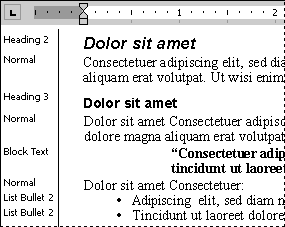
(What you get. - CK
Note)
Printing a List of Styles and their Formatting (CK
Addition)
You can print a list of the Styles in use in a document along with the
formatting that goes into that Style by selecting "Styles" in the "Print What"
box on the Print Dialog Box instead of printing the document.
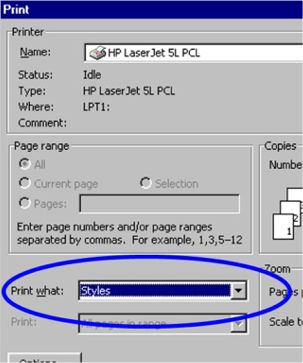
Let's say you just finished applying Styles to a long agreement only to
find that you applied the Heading 2 Style where you should have applied
the Heading 1 Style. This can easily be remedied by using Word's Find and
Replace feature. Instead of searching for text, however, you can tell Word
to search and replace text formatted with a specific Style.
Practice: Find and Replace Styles
- From the Edit menu, choose Replace. If you prefer keyboard
shortcuts, press CTRL+H.
- Click More on the Replace tab, if necessary, to display additional
options along the bottom portion of the dialog box. If a button says
Less, the window is already expanded.
- Delete any text, if necessary, that may appear in the Find what and
Replace with boxes.
- Click in the Find what box and click Format.
- Select Style.
- Select Heading 2 in the Find what Style list and click OK.
- Click in the Replace with box and click Format.
- Select Style.
- Select Heading 1 and click OK. Note that while there is no text
within each edit box (Find and Replace), just below each box is a
message that Word will find and replace Styles that are applied to text
within the document.
- Click Replace All, then click OK, and finally, click Close.
If you try to use the Find and Replace feature again, make sure to
click within each box (Find and Replace) and click No Formatting to reset
what Word is to search for.
Create, Modify and Locate Your Own Styles
Now that you understand what a Style is and what it can do, it's time
to create some Styles of your own. Not only can you create your own
Styles, you can modify existing Styles to achieve the result you need.
Create a New Style
The easiest way to create a new Style is to format text with the
attributes that you want to apply to the Style. It doesn't matter what you
type, only what type of paragraph and character formatting that you have
applied to the text. Formatting is the only thing that is applied when you
apply a Style. Although you can create Styles that have more advanced
attributes such as being followed by an entirely different Style, the
following exercise shows you just how easy the process can be.
Practice: Create a Style
- Type your first name on a separate line in a document.
- Select your name and make the font Blue.
- Change the font size to 24-points.
- Apply Bold and Underline formatting to the text.
- Center the paragraph.
- From the Formatting toolbar, click in the Styles box (where the
Style name Normal is usually displayed).
- Type your first name.
- Press ENTER. This step is important. If you do not press ENTER your
Style is not created.
- Click the Style drop-down list. You should see your newly created
Style.
- Test this by typing "This is a test" and applying the new
Style.
You can use the Style dialog box to create or modify a Style. Another
option for creating and modifying Styles is shown in the following
exercise. You create a new Style by typing text and formatting it, and
then from the Format menu, choose Style.
Practice: Create a Style Using The Style Dialog Box
- Type the following text:
Styles help users in law firms master Microsoft Word. (press
ENTER)
Everything in Word is based on a Style.
- Select the text "Styles help users in law firms master Microsoft Word."
and the paragraph mark (
 )
that follows. )
that follows.
- Center the paragraph and apply a 14-point font.
- From the Format menu, choose Style.
- Click New.
- Type My Style as the Name.
- Click OK, and then click Apply.
There are two ways to modify an existing Style. One of these methods is
through the Style dialog box. However, an easier method is by changing the
Style by example using the Style drop-down toolbar button. The Style
drop-down is useful if changes have already been manually made to a
paragraph formatted in the Style to be changed. If this is not the case,
Styles can be changed using the Style dialog box.
Practice: Two Methods to Modifying a Style
- Add several paragraphs to the document from the previous exercise.
- Apply the Style that you created to the new text.
- Select the text Styles help users in law firms master Microsoft
Word.
- From the Format menu, choose Style.
- Click Modify.
- Click Format, and then select Font.
- Change the font color to Blue and the font size to 20-points.
- Close the dialog box and apply the changes that you've made by
clicking Apply. Notice that all text formatted with My Style updates to
show the recent change.
- Select the text Microsoft Word.
- Change the font size to 36.
- Click on the Style name in the white part of the Style toolbar
button (not the drop-down arrow) and press ENTER. It's important to
press ENTER and not move the mouse up or down the list of Style names.
This tells Word that you are working with the current Style where the
mouse is active. If this step was done correctly, the following Modify
Style dialog box should display.
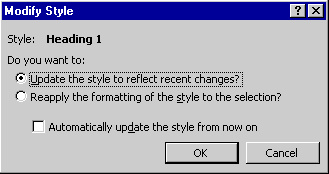
- You can either choose to Update the Style to reflect recent changes,
or Reapply the formatting of the Style to the selection (go back to the
original Style format). Choose Update the Style to reflect recent
changes? And click OK.
 |
CK
Note: This behavior
changed in Word 2002. You can modify Word to go back to the previous
behavior. Check the box for "Prompt to update Style" on the Edit tab
of Tools > Options.
You can download an Add-In that restores the CTRL+SHIFT+S
behavior from my
downloads page. Do
not ever check the box to automatically update the Style from
now on. This is the equivalent of giving a chain saw to an
8-year-old without supervision. Nothing good will come of it! |
 |
Tip A keyboard shortcut is to press
CTRL+SHIFT+S (to put you in the Style drop down box), and then press
ENTER, which will bring up the above dialog. |
The Style is changed to reflect the formatting of the selected text and
this method is referred to as modifying by example. Notice how all
paragraphs with the Style are updated automatically.
 |
Warning We do not recommend selecting the
Automatically update the Style box especially in a legal environment
where multiple users work on the same document. This feature will
update the Style each time you make a formatting change in a
paragraph that has a Style attached. |
A lot of confusion can come from not knowing where Styles are stored
and when they are available in documents. When new documents are created,
the new documents are based on templates. The Styles contained within
these templates are copied to the new document. Changes made to Styles in
the document as well as new Styles that you create only affect that one
new document by default. If you want the change or addition to be added to
the template, you have to tell Word to do so.
Practice: Add it to the Template
- From the Format menu, choose Style.
- Click Modify.
- Check the option to Add to template. This makes the Style available
for any new documents that are based on that template.
The Style is added to the currently open template.
 |
Note Documents that have previously been
created based on this template are not affected when you add a Style
to the template. To automatically update Style changes in templates
and files previously created based on the same template, from the
Tools menu, choose Templates and Add-Ins. Select the option to
Automatically update document Styles and click OK. We recommend not
checking this option. It can produce unexpected results, especially
in legal documents that must conform to court
rules.
CK
Note: For an excellent tutorial on
Styles and a methodical look at basing Styles
on one another and reasons not to base Styles on normal, see John McGhie's
Create
a Template Part 2. For a sample demonstrating Styles based on
one another, use of the Style for following paragraph feature, and the
AutoTextList field restricted by Styles download the Letterhead
Textboxes and Styles Tutorial by Charles Kenyon.
----- What it means to have a Style (Style B) based on another
Style (Style A) is that changes in Style A, the underlying Style,
will be reflected in Styles based on it (Style B) unless the new
Style has deviated from Style A on the feature being changed.
Style A Arial Bold 20 pt Indented .5 inches
Style B Arial Bold 18 pt Indented .5 inches based on Style A
Change Style A to Comic Sans font and Style B will also be Comic
Sans
Change Style A to 24 pt - no change to Style B
Change Style A to not Bold - Style B also becomes not bold See
How
Styles in Microsoft Word Cascade by Shauna Kelly, MVP
|
When you save a Style to the template, if that template is the normal
template, the Style will be available in all new documents.
Assign a Keyboard Shortcut To a Style
If you create your own Styles, it's especially helpful to assign a
keyboard shortcut to them to make them easier to apply. You can also apply
shortcuts to commonly used Styles.
Practice: Assign a Keyboard Shortcut to The Quote Style
- In a blank line on your document, change the left indent to 1", and
the right- indent to 5".
- Enter some text.
- Click somewhere within the indented paragraph. You will create a
quote Style that is very common in most law firms.
- From the Format menu, choose Style.
- Click New.
- In the Name box, type Quote.
- As Style type, select Paragraph.
- Based on should be Normal (your default Style).
- Click Shortcut Key.
- In the Press new shortcut key box, press the keyboard combination
ALT+Q. (Always make sure that the shortcut key you have chosen is not in
use somewhere else.)
- Click Assign.
- Click OK, and then click Close.
- Click anywhere within your document and press ALT+Q. The Quote
paragraph Style is applied.
Now you can apply the Quote Style using ALT+ Q or through the Style
menu.
 |
Note If you want to add a shortcut key to a
Style that already exists, Word lets you do that, too. From the
Format menu, choose Style. Select the Style to which you want to add
a shortcut key and click Modify. Click Shortcut Key and follow the
steps from the above exercise. |
Following a Style with Another Style
If you apply a paragraph format in Word, it keeps that format until
another one is chosen. This is true for Styles as well. If you use the "My
Style" Style (created in the previous exercise), Word continues to use
that Style each time you begin a new paragraph until another Style is
chosen. Sometimes the Style is only needed for one paragraph at a time
(for example a heading Style). To cut down the amount of times the user
needs to use the Style menu; you can choose which Style should be used in
the paragraph that follows the new Style. For example, after the Heading
Style, when you press ENTER, you can have the next paragraph automatically
formatted with a Body Text Style.
Practice: Follow a Style With Another Style
(Save Users Time & Frustration)
- From the Format menu, choose Style.
- Select Quote Style from the list of Styles.
- Click Modify.
- Select Normal Style from the Style for following paragraph list.
- Click OK, and then click Close.
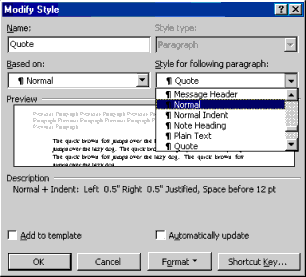
Notice the Style of the new paragraph automatically changes to the
Normal Style when you press enter after a paragraph formatted with the
"quote" Style.
CK Note: See Letterhead
Textboxes and Styles Tutorial for an example of Styles that use
the "Style for following paragraph" feature to good effect.
Using the Organizer to Copy Styles
You can copy Styles between documents or templates. One of the most
effective ways to do this is through the Organizer. The Organizer is a
tool built into Word that allows you to quickly copy Styles, AutoText,
Toolbars and Macros. You can access the Organizer in one of two ways: from
the Format menu, choose Style and click Organizer; or from the Tools menu,
choose Templates and Add-Ins and click Organizer.
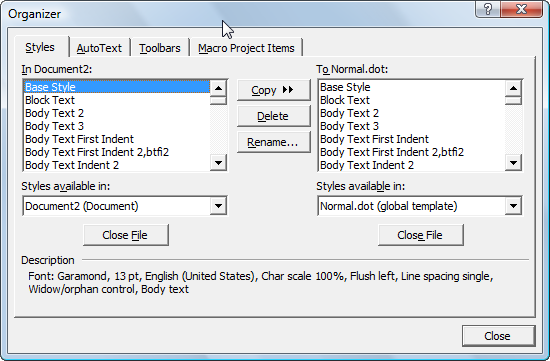
Word 97 Styles Organizer (above) - note AutoText and Toolbars tabs!
Word 2003 is the same.
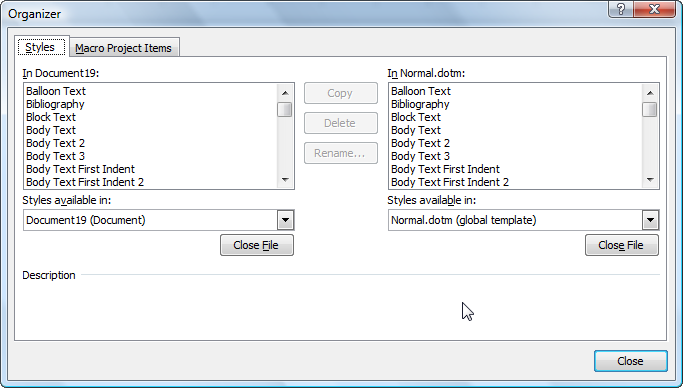
Word 2010 (2007, 2013 the same) Styles Organizer.
CK Note: To get to the organizer in Word
2010 and 2007 you need to click on the Import/Export button on the
Manage Styles Dialog Box (bottom left corner).

Practice: Copy Styles Using the Organizer
- From the Tools menu, choose Templates and Add-Ins.
- Click Organizer.
- Select the appropriate tab for items that you want to copy. For
example, to copy Styles from one document or template to another select
the Styles tab.
- To copy Styles from your current document to the Normal.dot template
which makes the Style available each time you start Word, select the
Styles and click Copy.
- Click Close.
 |
Note If a Style name that you are copying
already exists, you are asked if you want to replace
it.
Charles
Kenyon Note
I have found it best when copying Styles using the organizer to copy
them three times if any of the Styles is based on other Styles or is
followed by other Styles. I'm not sure why this makes a
difference, but I've found that clicking on that copy button three
times means that these relationships continue in the destination
template. I know that when I copy them only once, they do not and
the Styles are then followed by the Normal Style. See this
Knowledge
Base article
Q113106
for possible explanation.
Since at least Word 2003, the Organizer will not necessarily show
all of the Styles in the Normal template. See
below in troubleshooting.
You can use a global template as a Stylesheet if you include a
macro to copy the Styles into your document. See A Global
StyleSheet in Microsoft Word?
for an example of such a macro.
If you have defined one of the built-in Styles just the way you
want but would prefer to be using a Style of your own for this
purpose, copying the formatting to your new Style without it being
based on the existing Style. If you are comfortable editing vba
macros, you can record a macro that calls up the Style modification
dialog and goes through each of the various format dialogs and
closes them. Then create your new Style and edit the macro to refect
the name of your new Style rather than the one in which it was
recorded. Run the macro and the new Style should match your original
one.
Much simpler is using one of the tools that comes in the WOPR
Add-In. The Style Duplicator lets you create a new Style with the
same definition as an existing one. The WOPR Add-In is only
available with
Que "Special Edition" books about Office and is worth the price
of the books by itself. |
Another way to copy Styles is to simply copy and paste paragraphs
created in another document containing the Style you're looking for. All
paragraph formatting is contained in the paragraph mark at the end of
each paragraph. Make sure when you select and copy the paragraph text
that you include the paragraph marker at the end of the selected
paragraph. Then, when you paste it into the target document, the
selected paragraph formatting and paragraph Style are added to your
target document.
 |
CK
Note:
If you use Autotext
entries contained in a global template that
are formatted using a Style in that global template, those Styles will
be copied as well. (For this to work with paragraph Styles a paragraph
marker in the Style must be a part of the autotext entry.) This
method of copying Styles by copying text with a paragraph marker
only works if the Style being copied in is not already "in use"
in the document receiving the copied text. Otherwise the Style
definition in the target document governs. |
If you do this
and the Style already exists in the new receiving document, the existing
Style in the receiving document is used, not modified. This makes it
much easier to maintain consistency within a document but can lead to
real headaches if the people who formatted the documents weren't
conscious of Style use.
In this case if you wanted to copy the
Style you would want to use the Organizer. Character
Styles are
also copied this way. This gets complex. Sorry about that. Despite this
complexity, use of Styles for formatting is the key to using Word.
If you have text in two different documents that you want to
combine, and you want to retain the formatting from each rather than
having one Style system format the text from both documents, you can.
You can use Paste Special ... as Word Document
Object. This creates a
document within a document, with its own set of Styles.
Otherwise, if you just want to copy the text, you will need to make some changes to one of the documents before you
do the insertion, though. The thing is that if your Styles have
different names in the two documents, then the formatting will be
retained when the text is inserted. So, you'll want to rename the
Styles in one (or both) of your documents.
None of the built-in Styles can be renamed, though. If you have the
WOPR Add-In, you can copy Styles within a document and then use
replace to change all instances using one of the built-in Styles to
the copy (with a different name).
If you have problems with copying formatted text from one document
to another, take a look at the troubleshooting
section below. If you have other formatting problems such as headers and footers
or page numbering to worry about, take a look at Sections,
Header and Footers.
If you apply heading Styles, you can use the Vertical Scroll Bar in
Word to move quickly to different parts of your document. To do this,
click and drag the box (elevator car) in the vertical scrollbar and move
it up or down. You will see tip-text next to it that tells you which
section (heading) of your document you are in. (end of addition)
If you apply heading Styles, you can use the Document Map feature in
Word to quickly move to different parts of your document. This is a real
time-saver when working with long documents.
See warning below!
Practice: Navigate Using Document Map - but SEE
WARNING FIRST
- Create or open a long document formatted with heading Styles.
- Click the Document Map button on the Standard toolbar, or from the
View menu, choose Document Map.
- Click on a heading within the document map to move to that section
in the document.
- Click on a different heading in the document map to move to
another section within the document.
To turn off the document map feature, click the Document Map button
on the Standard toolbar. The button works as a toggle.
 |
CK
Note -
Warning:
"While it's true that Microsoft put a Document Map
feature into Word 97, the whole thing was so badly botched that
only a masochist would live with it. Here's the primary
problem: Word 97 takes it upon itself to scan every document as
it's opened and assign heading levels to all the paragraphs.
By doing so, any heading levels you've assigned are thrown
away--and there's nothing you can do about it.
"So here's a word of advice. If you use DocMap
on a particular Word document, don't let anybody with Word 97
(or any earlier version of Word, for that matter) open the
document. As soon as your carefully DocMapped Word 2000
document is opened in Word 97, all the level formatting will be
irretrievably lost."
Quote from Woody Leonard Teaches Office 2000.

The Document Map feature causes problems in all
versions of Word up through Word 2007. Do not use it. In
Word 2010 it was replaced with the Navigation Pane which works
nicely.
|
This section (other features) was added by CK and is not in the
original text. Four features that depend on use of Styles in a document
are:
AutoText lists are an implementation of the AutoTextList field. They
are found on the Header and Footer Toolbar and the AutoText toolbar.
They are also in a number of the templates supplied with Word. A
non-apparent factor with their use is that they are sensitive to Styles.
AutoText entries are organized by Word according to the Style in which
they were created. Often only AutoText entries saved in a particular
Style will show up in an AutoText list field. When such a list is
missing entries, the first thing to check is whether the insertion point
(cursor) is in the expected Style.
See the Web Resources
page for more on AutoText. See
How
to add pop-up lists to any Word document for more on the AutoTextList
field.
See the Letterhead
Textboxes and Styles Tutorial for an example using some of
Microsoft's default AutoText entries for letters.
Tables of Contents
Tables of Contents are very easily generated in Word if you use
heading Styles to mark your headings. See
Complex Documents
for more on how to do this. Creating a Table of Contents without
using Styles is a painful experience, although it can be done.
The StyleRef field
The StyleRef field is used primarily in headers and footers. If
you have something like a directory or a phone book document you can
have dynamic content in your header/footer like:
Allen - Brady
With a properly set up letterhead template the Styleref field can
be used to put information about the addressee and subject into the
continuation page header automatically. See the Letterhead
Textboxes and Styles Tutorial for a detailed example. See
my StyleRef Field
Tutorial,
Using Fields in Microsoft Word,
and
Useful StyleRef Field Tricks for
more on the StyleRef field. The StyleRef field is especially handy
because it updates instantly without any user intervention.
The Vertical Scroll bar
This was covered earlier.
A Style is a collection of formatting characteristics, such as
font name, size and color; and paragraph alignment and spacing.
A quick Style set is a collection of
Styles that are designed to
work well together. The built-in quick Style sets in Word 2007-2013 are
called Distinctive, Elegant, Fancy, etc. You can also create your own
Style sets.
Location: The English-language built-in quick
Style sets for Word 2007 should be in the folder:
C:\Program Files (x86)\Microsoft Office\Office12\1033\QuickStyles
("1033" refers to US English). Word 2010: Office14
instead of Office12. Word 2013: Office15 instead of
Office12.
If you are running 64 bit Office on 64 bit Windows (or 32 bit
Office on 32 bit Windows), the program files folder will be
called Program Files (without "(x86)").Your
custom quick Style sets (those you create) are located in
a completely different location. That folder will depend on your
operating system.
These custom files are in the following
folders:
Windows XP Location:
c:\Documents and Settings\{your username}\Application
Data\Microsoft\QuickStyles\
Windows Vista & 7-8 Location:
c:\Users\{your username}\AppData\Roaming\Microsoft\QuickStyles\
These are hidden system folders. If your Start menu has a search function
searching for %APPDATA% will lead you toward the correct folder.
Each Style linked in a Style set is called a Quick Style. Most
Styles
are not part of a quick Style set. Quick Style Sets do not contain
Styles, themselves. They link to Styles in the template and the document
and change certain attributes of those Styles. Quick Styles are also the
Styles displayed in the Quick Style Gallery.

The Home tab of the ribbon includes the Styles group. The
Styles group includes the Quick Styles Gallery and the Change Styles
button. When you choose a quick Style set for your document, the
individual quick Styles in the Style set appear in the Quick Style
Gallery. The Styles in the document that are part of a Quick Style Set
will change when you change sets to the definitions in the new set.
To see another representation of the quick Styles shown in the Quick
Style Gallery - one that will be familiar to someone who has worked with
Word 2003 and earlier - click on the sloping arrow in the lower right
corner of the Styles group (or press Ctrl+Alt+Shift+S) to open the
Styles Task Pane. This also shows Styles that are not Quick Styles,
though. That is, you get access to all Styles (or can if your options
are set to display not only recommended Styles or Styles in use, but all
Styles).

When you change to a different Style set, it changes two defaults in
your document. Since the Quick Styles are based on those defaults, they
all change. The first default is your base fonts. The second is which
Styles are labeled as Quick Styles and displayed in your Quick Style
Gallery.
Quick Style Sets can only be used in Word 2007 and later. In all
versions of Word, cascading Styles are available, though, where various
Styles are based upon one another and a change to one Style can ripple
through others. See
How
Styles in Microsoft Word cascade. This can give you many of the
advantages of Style Sets in any version, but are a bit more work.
Selecting All Text Formatted in a Particular
Style (and only that text)
The Quick Styles Gallery also allows the user to select the text
formatted with a particular Style, and only text formatted with that
Style. You do this by right-clicking on the Style name in the Quick
Style Gallery as shown below.
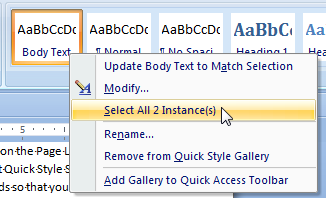
Once you have done this all instances of text in that Style (and not
instances of text in a Style based on that Style or other Styles) will
be selected in your document. A word count of the selection will appear
in the status bar.
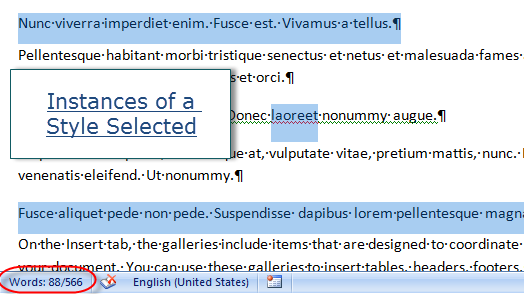
The screenshot shows the result for a linked
Style which has been used as both a paragraph and a character Style.
Note, this works only with Styles that have been
designated to appear in the Quick Style Gallery.
Using Themes in Microsoft Word
Themes were introduced in Word 2007 to allow dramatic changes
in the appearance of documents that work together. "One way
to think about themes is as design elements that affect the
aesthetic appearance of a document. Styles, on the other hand, are
geared more to the formatting of text and paragraphs." Herb
Tyson, MVP,
Microsoft Word 2010 Bible
p. 157
Every Office theme defines two
fonts — one for headings and one for body text. They
can be the
same font (used everywhere) or two different fonts. . . In
addition, Quick Style Galleries
for text and WordArt use
these same theme fonts.
Your author knows little about themes. So, rather than expose
ignorance, here are some references:
Troubleshooting Styles — Issues To Watch Out For
While Styles are an integral part of using Word in a law firm or any
environment, there are a few things that cause users difficulty. This
doesn't mean that you should not create your own Styles; you just need
to know how to solve some common problems and understand how you can
avoid them in the future.
A Style has changed unexpectedly
Check to see if automatic updating is turned on for the Style. With
automatic updating, a Style is updated automatically when you make
additional changes to the Style, meaning that every paragraph in your
document assigned to that Style will change automatically. To turn off
this feature, click the Format menu, and choose Style. Select the Style
in the Styles box, and then click Modify. If the Automatically update
check box is selected, clear it.
Your Style may have been based on another Style that has changed.
Changes to a base Style affect other Styles in the document that are
based on it. For example, if you change the font in Normal to the Arial
font, Word changes the font for the Styles used in footnotes, headers,
footers, page numbers, and other text. If you don't want a certain Style
to change when you change the base Style, make certain your Style is not
based on another Style. On the Format menu, click Style. In the Styles
box, click the Style you want to modify, click Modify, and then click
(no Style) in the Based on box.
CK Note: See also Word
is always making changes I don't expect. How can I get more control over
my formatting? by Suzanne S. Barnhill, MVP, and Dave Rado, MVP. and
Formatting applied to one paragraph affects entire document by
Suzanne S. Barnhill, MVP
|
 |
Warning When you base a Style on No Style, you
will need to set the Language because the default will be No
Proofing.
Charles Kenyon note: I recommend
that you not base any Styles on normal and that you change the
built-in Styles so that they are not based on normal. This is
particularly true for any Styles that are involved in paragraph
numbering. (But, I have been told by someone whose
opinion I respect that my reluctance to use the normal Style is
based on an urban myth.)
|
If you change the Styles in a template and then reopen a document based
on that template, Styles in the current document may be updated, based on
their new definitions in the template. If you don't want the Styles in
documents based on a particular template to update when you open the
documents, click Templates and Add-Ins on the Tools menu, and then clear
the Automatically update document Styles check box.
Charles Kenyon note: I recommend that
you keep the Automatically update Styles check box unchecked. Especially
if you will be sharing your documents with others, leaving it checked
can result in truly bizarre formatting and make your documents ugly or
even unusable. This is true even if you are using a custom template and
not normal.dot because...

if the template that contains the Style definitions is missing or
damaged, Styles in the current document use the Style definitions from the
Normal template.
Applying a Style turns off bold, italic, or underlining
Sometimes when you apply a Style that has specific formatting
attributes to text already formatted this way, the reverse formatting may
occur. For example, when you apply a Style that contains bold formatting
to a paragraph that contains some bold text, the bold text may lose its
bold formatting. This problem will not occur if you apply character
formatting— either through a character Style or direct formatting — after
you apply a paragraph Style. Apply the Style first, and then select the
words to have other formatting and apply the formatting directly.
 |
Tip To make sure that no direct formatting has
been applied to the text, first select the text completely and then
press CTRL+SPACEBAR. This removes manually applied formatting. Now
when a Style is applied, there is no reversing situation to
occur. |
Paragraphs with the same Style applied look different.
Often a Style will be applied within a document, and later, specific
text in the document is selected and additional formatting is
applied-without updating the Style. This is called direct formatting.
While direct formatting may be your intention, if you share documents with
others, it can be confusing because text formatted differently can have
the same Style name.
To remove direct formatting, select the paragraph, including the
paragraph mark, and then press CTRL+SPACEBAR to remove character
formatting and CTRL+Q to remove paragraph formatting.
Practice: Remove Direct Formatting & Return the
Style to the
Original Definition
- Apply a Style such as Heading 1 to text.
- Apply formatting such as Bold, Italic, and Underline to this text.
- In the same document, apply the same Style to different text and
note that the text displays the same Style name but appears with
different formatting.
- Select the Heading 1 text that has the directly applied character
formatting applied in step 2.
- Press CTRL+SPACEBAR to remove the directly applied character
formatting.
- Indent and center the text so that paragraph formatting is now
directly applied on top of the Style.
- Press CTRL+Q to remove the directly applied paragraph formatting.
Both paragraphs should now look the same.-
 |
CK
Note:
The following is not in the original chapter. |
Copying text formatted with a Style from
one document to another.
First, think about using Paste Special... As Word Document Object. This
may do what you want without your having to do a lot of work to otherwise
understand how your Styles are working. If it doesn't, read on...
When you copy text formatted in one Style to a different document,
different things will happen depending on whether that Style is already in
use in the original document. If the Style is based on a different Style,
it will also matter whether or not that Style is in use. The basic rule is
that if the Style is in use in both documents, the formatting of the Style
in the target document governs. If the Style is not "in use"
then the formatting of the Style from the source document will be carried
into the target document and override a Style definition for that (unused)
Style in the target document. Direct formatting can also cause problems.
When you run into a problem with this, first undo and close your
documents. Make some copies and work with the copies. Try first clearing
any direct formatting in the source
document text. Then copy and paste again. If your problem still pops up,
then try using Edit => Paste Special... => Unformatted Text. You may
have to reapply the appropriate Styles to the pasted text. The pasted text
will pick up the paragraph format of the paragraph into which it is being
pasted (even if the pasted text contains multiple paragraphs).
To see something of how Styles interact when copied from one document
to another, take a look at the
IncludeText
Field Tutorial. It shows what happens with Styles that are (1) in both
documents, (2) only in the source document but based on a Style in the target
document, and (3) only in the source document and not based on any Style in the
target document.
Changes I make to my default Styles don't stick!
Changes to Styles are changes to the normal template (normal.dot or
normal.dotm). When you tell Word you want a Style modification to apply
to all documents based on this template, you are making such a change.
A number of "Add-Ins" prevent these changes from sticking because of
poor programming. There are three methods to get around this.
- The most comprehensive is to talk to the people who wrote the
Add-In and get them to fix the problem they are causing you.
- The next is to disable the Add-In.
Enable or disable add-ins in Office programs - Support - Office.com
- The third is to open the normal template directly - as a
document - make your changes, and save that. You do not want to
put any text, including headers or footers, in the normal template!
How to find or open the normal template in Word. See also
Numbering Style Changes Won't Stick!
Style Organizer Not Showing All of
the Styles in the Normal Template
Beginning at least with Word 2003 there is an apparent bug in which
the Styles displayed for the normal template may be a short list. See
below:
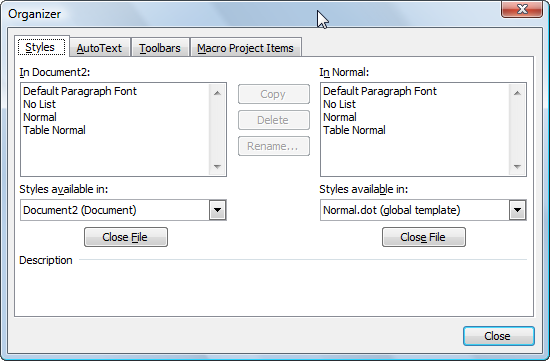
Word 2003 Organizer (safe mode)
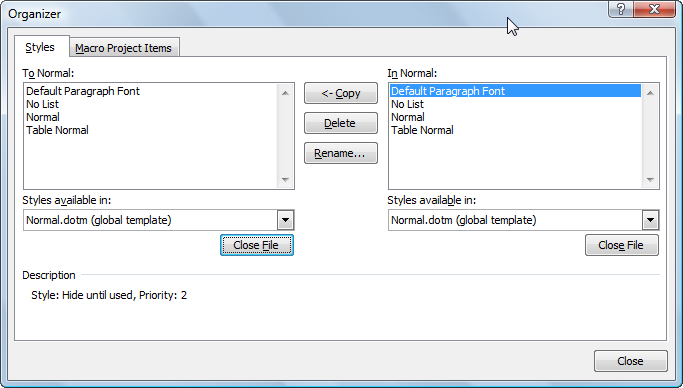
Word 2010 Styles Organizer - not showing all Styles in
normal template
As of this writing (Nov 2013) I have no explanation for this. In Word
2010 (but not Word 2007) changing the Styles viewed in the Styles Pane
expands the list of Styles shown in the Organizer (but not necessarily
to showing all Styles).
Note that it is rare to use the Organizer to copy Styles from the
normal template; I can't think of any reason to do this. You can copy
all of the Styles from the normal template (or any other template) by
attaching the template to the current document with the option checked
to update Styles from the template. You do not want to leave this option
checked, though!
Here is a macro that will do this.
Sub RefreshNormalStyles()
'
' RefreshNormalStyles Macro
' Written 2013-11-09 by Charles Kyle Kenyon
'
' Applies stored
Styles in normal template to current document.
'
' Note, this macro does not care where your user templates
' and normal template are stored.
' Word already knows that.
' This macro should work in any version of Word from
' Word 97 on but I've only tested it with Word 2010.
'
Dim strNormal As String
strNormal = Application.NormalTemplate.FullName
With ActiveDocument
.UpdateStylesOnOpen = True
.AttachedTemplate = strNormal
End With
ActiveDocument.UpdateStylesOnOpen = False
End Sub
See
Installing Macros by Graham Mayor for instructions on what to do
with this macro if you don't know.
Automatically Update Styles - three controls with the same name spell
trouble!
Word has three places where you can control automatic updating of
Styles. Each controls something a little different, two should be left
turned off as a rule, the third should always be turned on.
The first is in the Style definition itself. The dialog box below is
from Word 97, but the checkbox is in the Style modification / definition
dialog for all versions of Word thereafter. Leave it unchecked!
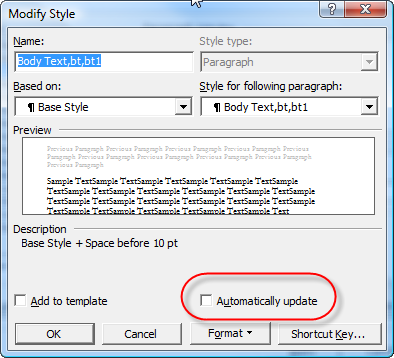
The second big one is in the document template dialog,
also called the Templates and Add-Ins dialog box. Directly under the
name of the attached template is a choice to automatically update
Styles. Leave it unchecked! Again, basically unchanged through the
versions:

Finally, Word has had an option since Word 2002 to be
prompted for a Style update. This was the default in earlier versions of
Word. Leave that one CHECKED.
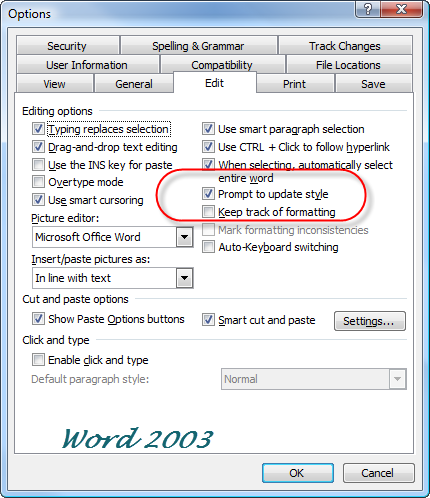

(end
of CK Addition)
See also Troubleshooting
|
 views since 14 April 2004
views since 14 April 2004
 Copyright 2000, Microsoft Corporation. Copyright 2000, Microsoft Corporation.
Copyright 2000-2002, 2004-2006, 2010-2026
Charles
Kyle Kenyon
See information about copy permission.
Search Intermediate Users Guide to Microsoft Word Using Google My office page as a
Madison,
Wisconsin Criminal Defense Lawyer.
Original Legal Users Guide to Microsoft Word 2002 - Documents in Zip Format
A note about link exchanges. This site does not participate in
link exchanges to build web presence. If you have a link that you think would be
of use to people reading this page, please send it to the webmaster with the url
of the page where you think it should appear and it will be considered. Your
placing a link to this site will not affect the decision on whether to add your
link, though.
|
views since 14 April 2004
 Copyright 2000, Microsoft Corporation.
Copyright 2000, Microsoft Corporation.



 Applies to all the text within the end paragraph mark of
where your pointer is positioned.
Applies to all the text within the end paragraph mark of
where your pointer is positioned.  Applies at the character level—to blocks of words and
letters.
Applies at the character level—to blocks of words and
letters.  . Provides a consistent look to lists.
. Provides a consistent look to lists.
 . Provides a consistent look to tables.
. Provides a consistent look to tables.




 In Word 2007 and later
at the bottom of this Style pane there are two checkboxes, three buttons,
and the Options... choice.
In Word 2007 and later
at the bottom of this Style pane there are two checkboxes, three buttons,
and the Options... choice.





































